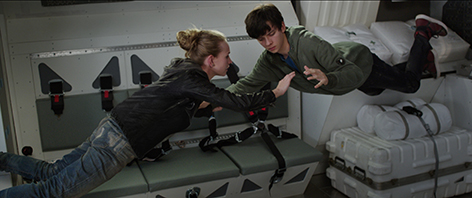Mars comes closer to the Earth Monday than it has at any time since 2005, making the reddish dot in the night sky look brighter and slightly bigger than usual for a few days. Expect the Red Planet’s place in earthlings’ imaginations to loom large for months, however, as a new Hollywood film this summer and a television series in the fall take viewers on adventures to Mars.
“If we can spread consensus and build community, we can create energy to send humans to Mars that will cross presidential administrations.”
The Space Between Us, expected in theaters on 19 August, weaves a story about a mission to colonize Mars and the first human born on the Red Planet, where the gravity is about 3/8 that of Earth. It tells the tale of that Mars boy’s adventures and health issues while visiting the Earth and the girl there whom he met online. Then, starting in November, a multipart Mars series airing on the National Geographic Channel will offer a story, in fact and fiction, of a dramatized first landing and attempt to establish a permanent human settlement on Mars in 2033.
These dramatizations are coming out as NASA moves ahead with real preparatory missions and the development of powerful launch rockets to take the first humans to Mars in the 2030s. The European Space Agency has likewise announced that it expects to land people on Mars in the same time frame. Private companies have also announced manned Mars missions.
“There is significant momentum toward a long-term executable, sustainable humans-to-Mars program,” Scott Hubbard, technical adviser to the new film, said at the Humans to Mars conference in Washington, D. C., earlier this month. “If we can spread consensus and build community, we can create energy to send humans to Mars that will cross presidential administrations.”
Providing Film Advice
Films and television shows like those coming up can build public support for sending people to Mars, Hubbard, a strong proponent of manned Mars exploration, told Eos in an interview. Often called the “Mars czar,” Hubbard was NASA’s first Mars program director and later directed the agency’s Ames Research Center in Moffett Field, Calif.; currently, he leads the Center of Excellence for Commercial Space Transportation at Stanford University in Stanford, Calif.

As the film’s technical adviser, Hubbard got involved in many science questions, including how long it takes to get to the planet’s surface, how to build an outpost there, and what happens if a child gestated in zero gravity but was born and grew up in the 3/8 gravity of Mars. Hubbard recalled some space shuttle experiments on fertilized frog eggs that developed anomalies in their hearts, lungs, and bone structure. As a result of discussions with the film’s director, producer, and writer, the movie includes sequences of efforts to try to strengthen the young man’s heart to allow him to live on Earth, Hubbard said.
“You don’t want to interrupt [a movie] for real science. You have to keep moving.”
In some other instances, Hubbard simplified the science for the film’s team. For example, asked about how people could communicate quickly between Mars and Earth, Hubbard initially launched into an explanation of the entanglement aspect of quantum mechanics but then stopped himself. Instead, he just told the movie makers to call the communications capability “quantum.com.”
At times, the film team said they needed to maintain the story’s pace and could not get into all of the details. Hubbard recalled being OK with that: “They’re storytellers, they’re not scientists,” he said, noting that in a movie “you don’t want to interrupt it for real science. You have to keep moving.”
Sometimes, “you have to invoke magic or just ignore [a science problem] or say, ‘ah, there’s some phenomenon in the future that we’ll be able to use,’” he added.
Walking and Chewing Gum
Hubbard said he’s confident that people can go to Mars in the 2030s, first orbiting and then landing. “We are, in fact, closer to having humans to Mars than we have been in decades,” he said, because of NASA’s commitment, robotic studies of the planet, and commercial firms flying cargo to the International Space Station, among other initiatives.
Addressing critics who say that exploring Mars uses resources that should be spent addressing humanitarian issues at home, Hubbard told Eos that he thinks it’s possible to handle both.
“A great nation can walk and chew gum at the same time. We can work on homelessness and explore,” he said. “Historically, great nations explore. Those that don’t—[those] that drain the moat and pull up the drawbridge—stagnate.”
—Randy Showstack, Staff Writer
Citation:
Showstack, R. (2016), As Mars gets close, so does a blitz of Red Planet dramas, Eos, 97, https://doi.org/10.1029/2016EO053279. Published on 27 May 2016.
Text © 2016. The authors. CC BY-NC-ND 3.0
Except where otherwise noted, images are subject to copyright. Any reuse without express permission from the copyright owner is prohibited.

